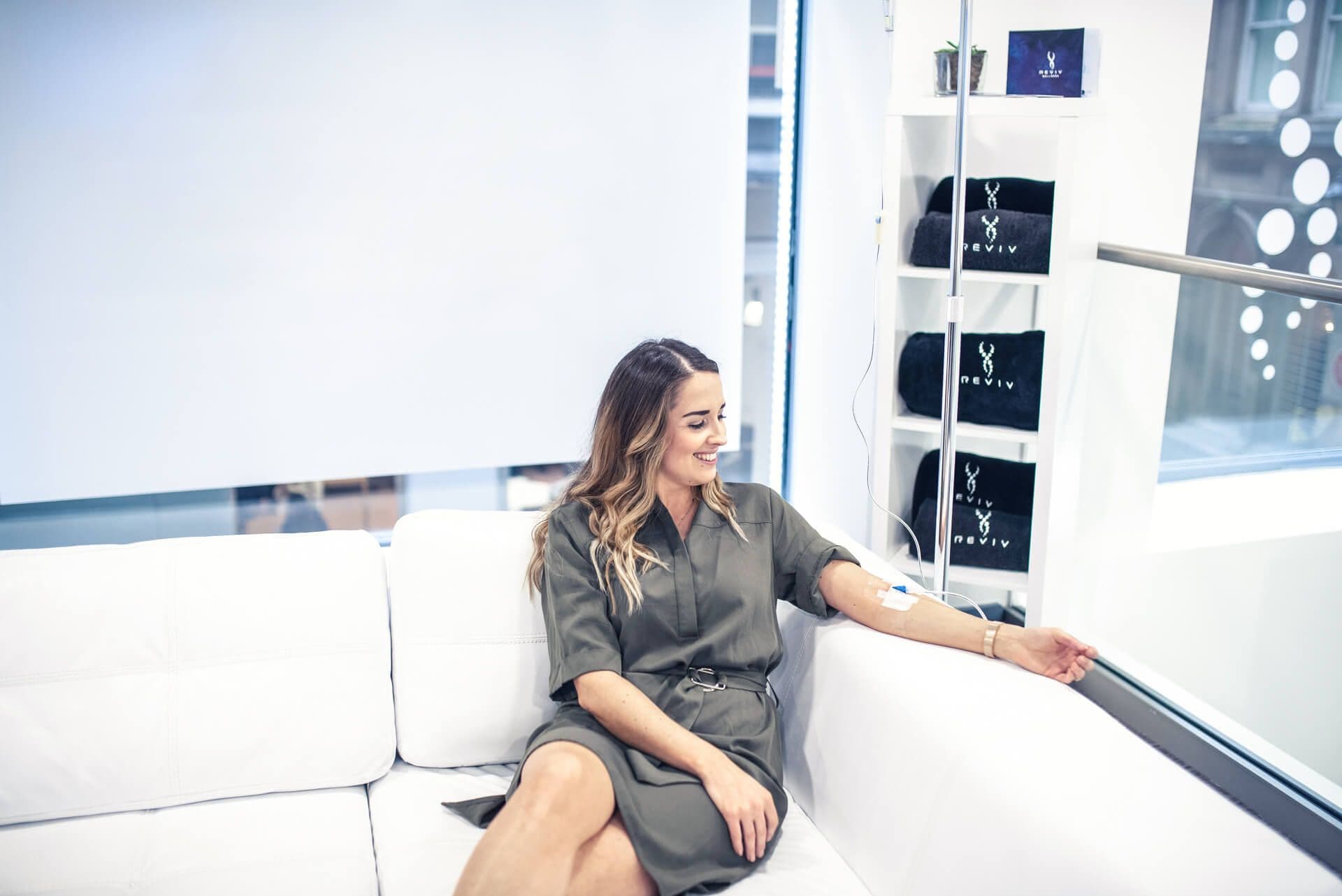The quiet strength of red and infrared light therapy

Red and infrared LED light therapy has gained significant popularity in recent years, becoming a staple treatment for those interested in supercharging their overall wellness, rejuvenating skin, supporting recovery, and boosting cellular function. But what exactly makes this therapy so appealing? Let’s dive into the science behind red and infrared LED light therapy, explore its numerous health benefits, and see how combining it with antioxidant and hydration IV therapy at REVIV can take your wellness journey to a whole new level.
Understanding red and infrared light therapy
Red and infrared LED light therapy, also known as photobiomodulation, harnesses specific wavelengths of light (ranging from approximately 630 to 850 nm) to stimulate biological processes at a cellular level. Unlike harmful UV rays, these wavelengths are safe, non-invasive, and have no downtime. Red wavelengths (around 630–660 nm) penetrate superficial skin layers, whereas infrared wavelengths (around 800–850 nm) go deeper, reaching muscles, joints, and tissues beneath.
When your cells absorb these wavelengths of light, mitochondria, the powerhouses of your cells, increase the production of adenosine triphosphate (ATP), your body's primary source of cellular energy. Higher ATP levels support various biological functions, such as cell regeneration, healing, reducing inflammation, and enhancing collagen production.
Clinical evidence supports the effectiveness of red and near-infrared light therapy, with studies such as the 2014 review published in the Journal of Photochemistry and Photobiology PMC3926176 highlighting its ability to improve skin health, support tissue repair, reduce inflammation, and modulate cellular function through mitochondrial stimulation and increased ATP production.

The benefits of red and infrared light therapy
1. Improved skin health and pro-aging: Red LED light therapy is beloved for its potential to boost collagen production, improving skin elasticity and reducing visible signs of aging, such as fine lines and wrinkles. Regular treatments help promote a smoother, brighter, and more youthful complexion by supporting natural skin rejuvenation processes.
2. Improved healing and recovery: Infrared light penetrates deeper tissue layers, potentially promoting faster healing from injuries, surgeries, or workouts. Athletes and active individuals often use this therapy to support muscle recovery, reduce soreness, and manage chronic joint discomfort.
3. Reduced inflammation: Photobiomodulation helps manage inflammation by promoting natural cellular repair processes. Those dealing with inflammatory conditions or joint issues often experience relief with regular infrared light treatments.
4. Enhanced muscle performance: Because infrared wavelengths reach deeper muscles, they support your body's regenerative processes. By improving circulation and nutrient delivery, infrared therapy helps muscles function more efficiently, aiding endurance, strength, and recovery.
5. Relief from joint discomfort: Individuals experiencing joint discomfort or stiffness due to conditions like arthritis often find infrared therapy supportive, helping to ease discomfort by increasing blood flow and promoting cellular regeneration and collagen synthesis around affected areas.
6. Improved mood and mental clarity: Red and infrared therapy may indirectly contribute to mood improvement. Regular sessions help promote relaxation, reduce stress levels, and support overall mental clarity, making this therapy beneficial for managing the stress of everyday life.
7. Hair growth support: Studies suggest that red LED therapy encourages hair follicles to shift into a growth phase, potentially benefiting individuals experiencing hair thinning or loss.
8. Sleep quality enhancement: Infrared therapy’s calming effects and potential to balance circadian rhythms improve sleep quality, helping users feel more refreshed and energized throughout the day.
9. Cognitive health and neurological support: Emerging research indicates that red and infrared wavelengths may offer cognitive benefits by supporting mitochondrial function in neurons, thus potentially playing a role in maintaining overall brain health.
10. Immune support: Consistent red and infrared therapy sessions can support overall immune function by promoting systemic wellness, aiding cellular regeneration, and reducing inflammation.
Steady mode, 10 Hz and 40 Hz pulsing
Advanced red and infrared LED devices often offer multiple frequency modes, allowing users to tailor treatments to specific wellness goals. Each frequency interacts with the body differently by influencing biological rhythms, nervous system activity, and cellular signaling pathways.
Steady mode delivers uninterrupted light. This continuous exposure saturates cells with photonic energy, helping optimize mitochondrial ATP production and cellular repair. It’s particularly effective for skin rejuvenation, wound healing, reducing inflammation, and boosting circulation. Steady mode is often used to support collagen synthesis, improve skin tone, and accelerate recovery from soft tissue injuries. It is also ideal for baseline systemic support and general wellness protocols.
10 Hz pulsing, which emits light at a frequency of 10 pulses per second, is often used to promote deep relaxation and activate the parasympathetic nervous system. This frequency has been associated with stress relief, reduced cortisol levels, and enhanced lymphatic flow. It's particularly effective after physical activity, making it popular for post-exercise recovery, muscle relaxation, and circulatory support. 10 Hz also helps improve sleep onset by calming neural activity and promoting a meditative state.
40 Hz frequency, or gamma-band stimulation, has gained attention for its potential neurological and cognitive effects. Research suggests 40 Hz pulsing may help synchronize cortical oscillations, which are often disrupted in conditions like Alzheimer’s disease. This frequency is being studied for its ability to enhance memory, improve attention, and support neuroplasticity. Users often report increased mental clarity, focus, and mood stability with consistent use. Additionally, 40 Hz stimulation may play a role in neuroimmune modulation and long-term brain health.
By understanding and selecting the appropriate frequency mode, users can precisely target concerns ranging from skin health and muscle recovery to cognitive performance and emotional well-being, making LED therapy a versatile tool in a modern wellness regimen.

Is red and infrared LED therapy safe?
Red and infrared LED therapy is widely regarded as safe, non-invasive, and well-tolerated when used as directed. Unlike UV-based treatments, these wavelengths do not damage DNA or burn the skin. Instead, they deliver therapeutic light energy that supports natural biological processes without downtime or discomfort. Most users report a soothing warmth or mild tingling during sessions, but no pain.
For general wellness and skin rejuvenation, sessions typically last 10 to 20 minutes per treatment area, depending on the wavelength intensity, device type, and desired outcomes. When targeting deeper tissues or musculoskeletal issues, sessions may extend up to 30 minutes, especially when using near-infrared wavelengths.
As for frequency, 3 to 5 sessions per week is often recommended during the initial phase (typically 4 to 6 weeks) to build up cumulative cellular effects. After this period, maintenance sessions once or twice weekly may be sufficient to preserve results. It’s important to follow the specific protocol recommended by your device provider or healthcare practitioner, as overtreatment does not translate into better results and may diminish the therapy’s effectiveness over time.
While red and infrared LED therapy has an excellent safety profile, individuals with certain conditions, such as epilepsy, light sensitivity, or active skin lesions, should consult a qualified practitioner before beginning treatment. Always ensure that devices meet medical-grade standards and are used according to manufacturer instructions.
Why proximity matters in red light therapy
When it comes to red and infrared LED therapy, don’t be misled by flashy marketing claims: proximity matters. For effective photobiomodulation, the light source needs to be placed as close to the skin as possible, ideally within a few centimeters, to ensure optimal energy absorption by the cells. Many consumer devices underdeliver simply because they lack sufficient irradiance or are used too far from the body, dramatically reducing their therapeutic value. Unless you're using a clinically validated, high-output device specifically designed for distance-based treatment, keeping the LEDs close to your skin is essential for achieving real results. Always look for technical specs like irradiance (measured in mW/cm²) and wavelength accuracy before trusting a product’s effectiveness.

Pair red light with IV support for maximum impact
Are you looking to support your skin’s youthful glow, speed up recovery from workouts, support joint health, or simply give yourself a wellness boost? Red and infrared LED light therapy could be the missing piece in your health regimen.
For those interested in amplifying these effects, pairing your Red Light Therapy sessions with REVIV’s antioxidant and hydration IV therapies could supercharge your results, giving your overall wellbeing and vitality a boost from the inside out.
Contact your nearest REVIV clinic today, and let us help you create a personalized wellness journey, revitalizing your cells and rejuvenating your body from within.
Subscribe to our newsletter
Get the latest articles and updates straight to your inbox.
SIMILAR NEWS

Coffee. Is It Good Or Is It Bad? The Verdict
SEPTEMBER 29, 2020
It is an age-old question. Is coffee good or is it bad for you. Well the answer is absolutely locked within your genes. Genetic advances have made it now common place to explore the secrets within your genetic make-up. Revealing whether coffee is good or bad for you is one of the nuggets of information that can be discovered.

Hydromax – REVIV’s Pure IV Hydration Therapy
OCTOBER 10, 2016
Intravenous or IV hydration has long been used by people in medical field for restoring fluids, replacing electrolytes, and administering nutrients when there is a barrier to oral intake. Originally reserved only for the severely ill, IV therapy, has over the years become more commonly utilized for preventative purposes and for people looking for fast recovery.
What started out as therapies administered in doctor’s offices are now commonplace in IV bars, med spas and lounges often offering additional therapies such as B12, Glutathione, IV vitamins drips and even IV for hangovers!
